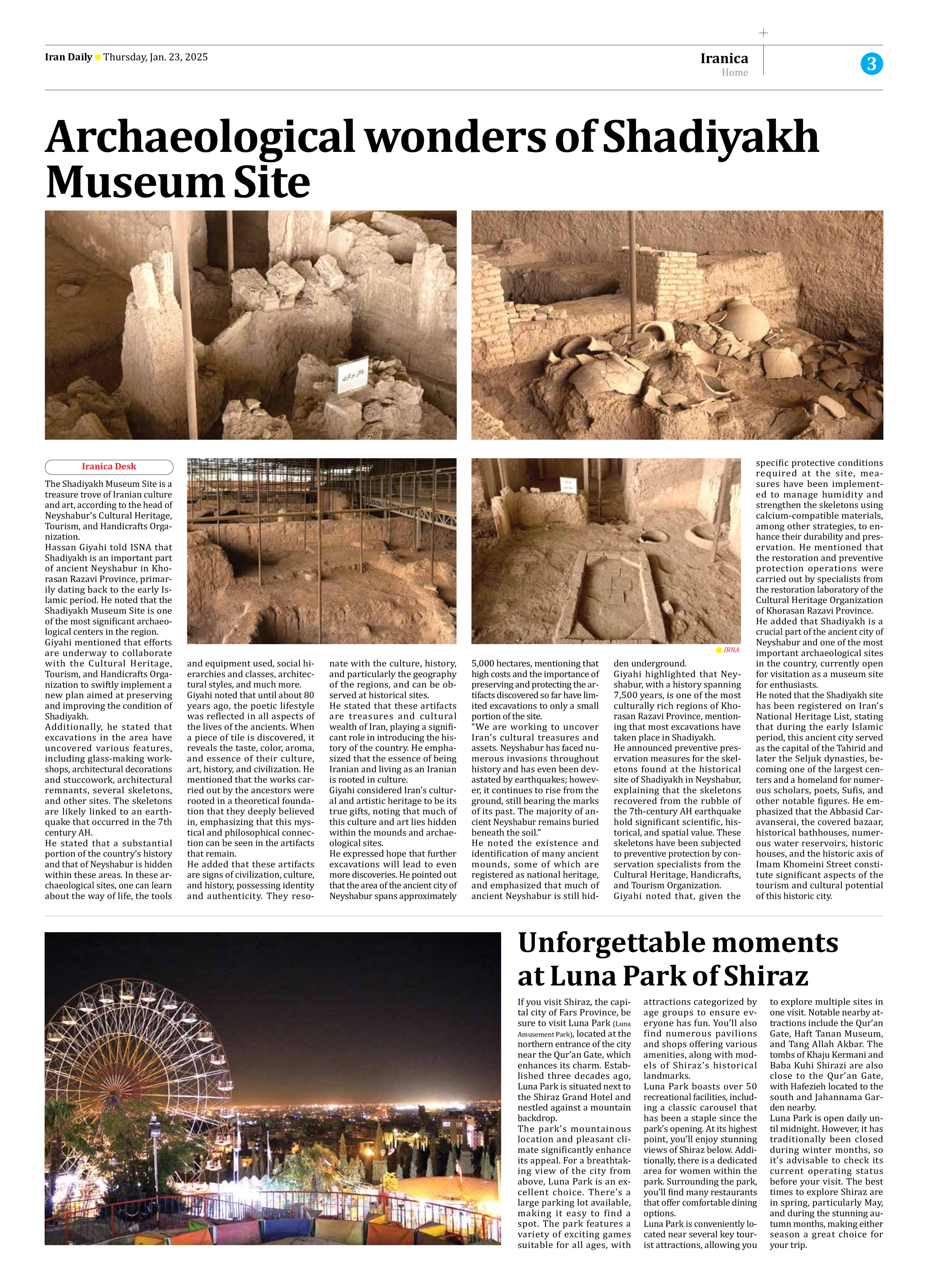
Archaeological wonders of Shadiyakh Museum Site
The Shadiyakh Museum Site is a treasure trove of Iranian culture and art, according to the head of Neyshabur’s Cultural Heritage, Tourism, and Handicrafts Organization.
Hassan Giyahi told ISNA that Shadiyakh is an important part of ancient Neyshabur in Khorasan Razavi Province, primarily dating back to the early Islamic period. He noted that the Shadiyakh Museum Site is one of the most significant archaeological centers in the region.
Giyahi mentioned that efforts are underway to collaborate with the Cultural Heritage, Tourism, and Handicrafts Organization to swiftly implement a new plan aimed at preserving and improving the condition of Shadiyakh.
Additionally, he stated that excavations in the area have uncovered various features, including glass-making workshops, architectural decorations and stuccowork, architectural remnants, several skeletons, and other sites. The skeletons are likely linked to an earthquake that occurred in the 7th century AH.
He stated that a substantial portion of the country’s history and that of Neyshabur is hidden within these areas. In these archaeological sites, one can learn about the way of life, the tools and equipment used, social hierarchies and classes, architectural styles, and much more.
Giyahi noted that until about 80 years ago, the poetic lifestyle was reflected in all aspects of the lives of the ancients. When a piece of tile is discovered, it reveals the taste, color, aroma, and essence of their culture, art, history, and civilization. He mentioned that the works carried out by the ancestors were rooted in a theoretical foundation that they deeply believed in, emphasizing that this mystical and philosophical connection can be seen in the artifacts that remain.
He added that these artifacts are signs of civilization, culture, and history, possessing identity and authenticity. They resonate with the culture, history, and particularly the geography of the regions, and can be observed at historical sites.
He stated that these artifacts are treasures and cultural wealth of Iran, playing a significant role in introducing the history of the country. He emphasized that the essence of being Iranian and living as an Iranian is rooted in culture.
Giyahi considered Iran’s cultural and artistic heritage to be its true gifts, noting that much of this culture and art lies hidden within the mounds and archaeological sites.
He expressed hope that further excavations will lead to even more discoveries. He pointed out that the area of the ancient city of Neyshabur spans approximately 5,000 hectares, mentioning that high costs and the importance of preserving and protecting the artifacts discovered so far have limited excavations to only a small portion of the site.
“We are working to uncover Iran’s cultural treasures and assets. Neyshabur has faced numerous invasions throughout history and has even been devastated by earthquakes; however, it continues to rise from the ground, still bearing the marks of its past. The majority of ancient Neyshabur remains buried beneath the soil.”
He noted the existence and identification of many ancient mounds, some of which are registered as national heritage, and emphasized that much of ancient Neyshabur is still hidden underground.
Giyahi highlighted that Neyshabur, with a history spanning 7,500 years, is one of the most culturally rich regions of Khorasan Razavi Province, mentioning that most excavations have taken place in Shadiyakh.
He announced preventive preservation measures for the skeletons found at the historical site of Shadiyakh in Neyshabur, explaining that the skeletons recovered from the rubble of the 7th-century AH earthquake hold significant scientific, historical, and spatial value. These skeletons have been subjected to preventive protection by conservation specialists from the Cultural Heritage, Handicrafts, and Tourism Organization.
Giyahi noted that, given the specific protective conditions required at the site, measures have been implemented to manage humidity and strengthen the skeletons using calcium-compatible materials, among other strategies, to enhance their durability and preservation. He mentioned that the restoration and preventive protection operations were carried out by specialists from the restoration laboratory of the Cultural Heritage Organization of Khorasan Razavi Province.
He added that Shadiyakh is a crucial part of the ancient city of Neyshabur and one of the most important archaeological sites in the country, currently open for visitation as a museum site for enthusiasts.
He noted that the Shadiyakh site has been registered on Iran’s National Heritage List, stating that during the early Islamic period, this ancient city served as the capital of the Tahirid and later the Seljuk dynasties, becoming one of the largest centers and a homeland for numerous scholars, poets, Sufis, and other notable figures. He emphasized that the Abbasid Caravanserai, the covered bazaar, historical bathhouses, numerous water reservoirs, historic houses, and the historic axis of Imam Khomeini Street constitute significant aspects of the tourism and cultural potential of this historic city.







